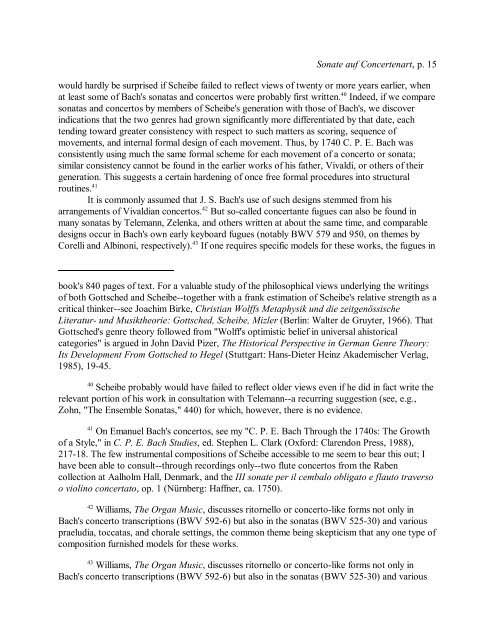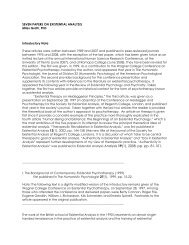The Sonate auf Concertenart: A Postmodern Invention? David ...
The Sonate auf Concertenart: A Postmodern Invention? David ...
The Sonate auf Concertenart: A Postmodern Invention? David ...
You also want an ePaper? Increase the reach of your titles
YUMPU automatically turns print PDFs into web optimized ePapers that Google loves.
<strong>Sonate</strong> <strong>auf</strong> <strong>Concertenart</strong>, p. 15<br />
would hardly be surprised if Scheibe failed to reflect views of twenty or more years earlier, when<br />
40<br />
at least some of Bach's sonatas and concertos were probably first written. Indeed, if we compare<br />
sonatas and concertos by members of Scheibe's generation with those of Bach's, we discover<br />
indications that the two genres had grown significantly more differentiated by that date, each<br />
tending toward greater consistency with respect to such matters as scoring, sequence of<br />
movements, and internal formal design of each movement. Thus, by 1740 C. P. E. Bach was<br />
consistently using much the same formal scheme for each movement of a concerto or sonata;<br />
similar consistency cannot be found in the earlier works of his father, Vivaldi, or others of their<br />
generation. This suggests a certain hardening of once free formal procedures into structural<br />
routines. 41<br />
It is commonly assumed that J. S. Bach's use of such designs stemmed from his<br />
42<br />
arrangements of Vivaldian concertos. But so-called concertante fugues can also be found in<br />
many sonatas by Telemann, Zelenka, and others written at about the same time, and comparable<br />
designs occur in Bach's own early keyboard fugues (notably BWV 579 and 950, on themes by<br />
43<br />
Corelli and Albinoni, respectively). If one requires specific models for these works, the fugues in<br />
book's 840 pages of text. For a valuable study of the philosophical views underlying the writings<br />
of both Gottsched and Scheibe--together with a frank estimation of Scheibe's relative strength as a<br />
critical thinker--see Joachim Birke, Christian Wolffs Metaphysik und die zeitgenössische<br />
Literatur- und Musiktheorie: Gottsched, Scheibe, Mizler (Berlin: Walter de Gruyter, 1966). That<br />
Gottsched's genre theory followed from "Wolff's optimistic belief in universal ahistorical<br />
categories" is argued in John <strong>David</strong> Pizer, <strong>The</strong> Historical Perspective in German Genre <strong>The</strong>ory:<br />
Its Development From Gottsched to Hegel (Stuttgart: Hans-Dieter Heinz Akademischer Verlag,<br />
1985), 19-45.<br />
40<br />
Scheibe probably would have failed to reflect older views even if he did in fact write the<br />
relevant portion of his work in consultation with Telemann--a recurring suggestion (see, e.g.,<br />
Zohn, "<strong>The</strong> Ensemble Sonatas," 440) for which, however, there is no evidence.<br />
41<br />
On Emanuel Bach's concertos, see my "C. P. E. Bach Through the 1740s: <strong>The</strong> Growth<br />
of a Style," in C. P. E. Bach Studies, ed. Stephen L. Clark (Oxford: Clarendon Press, 1988),<br />
217-18. <strong>The</strong> few instrumental compositions of Scheibe accessible to me seem to bear this out; I<br />
have been able to consult--through recordings only--two flute concertos from the Raben<br />
collection at Aalholm Hall, Denmark, and the III sonate per il cembalo obligato e flauto traverso<br />
o violino concertato, op. 1 (Nürnberg: Haffner, ca. 1750).<br />
42<br />
Williams, <strong>The</strong> Organ Music, discusses ritornello or concerto-like forms not only in<br />
Bach's concerto transcriptions (BWV 592-6) but also in the sonatas (BWV 525-30) and various<br />
praeludia, toccatas, and chorale settings, the common theme being skepticism that any one type of<br />
composition furnished models for these works.<br />
43 Williams, <strong>The</strong> Organ Music, discusses ritornello or concerto-like forms not only in<br />
Bach's concerto transcriptions (BWV 592-6) but also in the sonatas (BWV 525-30) and various















